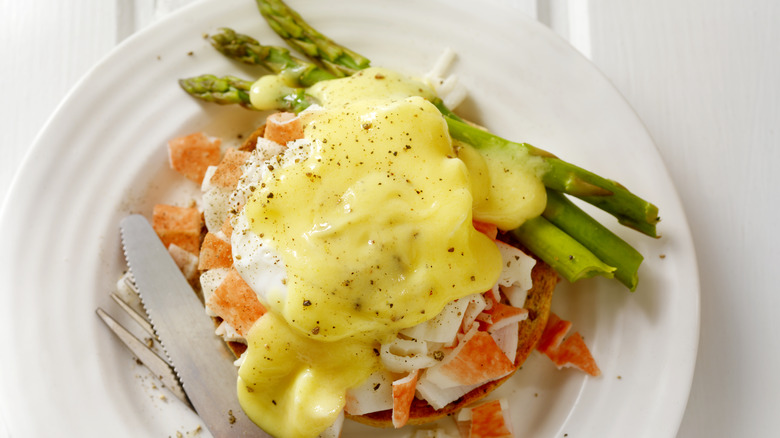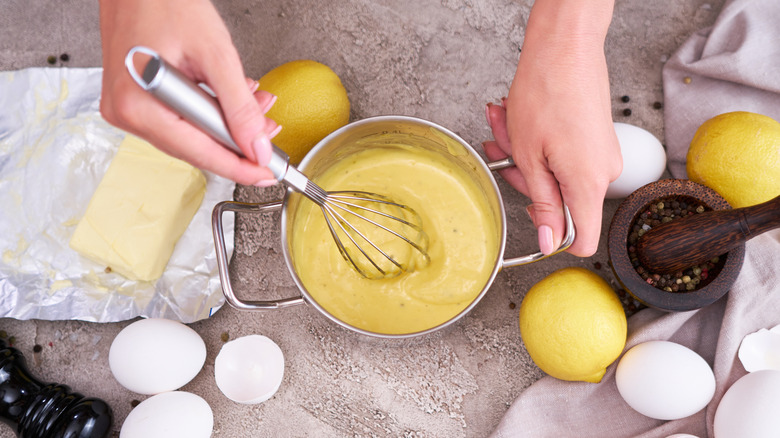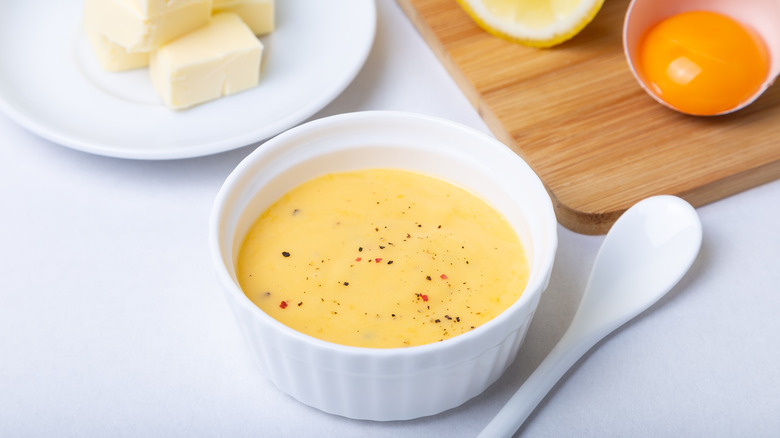Why Reheating Hollandaise Sauce Can Be Such A Pain
Few sauces inspire as much dread in the hearts of both home and professional cooks as hollandaise sauce. While there is nothing quite like this silky, smooth, pale yellow sauce draped over poached eggs, it can be tricky to make and even more difficult to reheat. Classic hollandaise sauce is made by creating an emulsion of egg yolks, melted butter, and an acid to stabilize it. Typically, the egg yolks are slowly warmed in a bowl set over simmering water as drops of warm butter are added while steadily whisking to control the rate of heat. Too high a heat will split the sauce, causing the components to separate or the eggs to curdle. While reheating hollandaise is possible, the temperature of the individual ingredients can no longer be carefully controlled, so it must be done with caution.
Reheating is so tricky that many cooks and chefs recommend starting from scratch. However, reheating hollandaise is possible if done slowly, and it might require some trial and error due to differences in appliances and methods.
The best way to reheat hollandaise sauce
Hollandaise sauce can be kept refrigerated for up to two days if it is stored correctly after cooling and not left out for more than two hours, which promotes bacterial growth. It will thicken as it cools due to the fat solidifying and needs to be reheated to the desired texture without further cooking the eggs or splitting the sauce. Using a microwave is one way to control the heat, but it must be done slowly, generally in 10- to 15-second intervals, stirring each time until the desired texture is achieved. If you have a particularly powerful microwave, lower the increments as needed. If the sauce isn't coming together or is too thick, a teaspoon of hot water can be whisked in.
A bowl set over hot water or sous vide reheating — over a temperature-controlled water bath — can work, too, but again, this should be done slowly. Sous vide might be the best method if you have the correct tool because the temperature can be set below the typical breaking point of 160 degrees Fahrenheit. Again, whisk in a little warm water if the texture isn't right.
Tips for making unbreakable hollandaise sauce
Of course, to get to the point of needing to reheat hollandaise, you have to make it right the first time. Using a double boiler to temper the egg yolks and adding the melted butter slowly while whisking is tricky to master. If the sauce breaks while carefully whisking melted butter into your egg mixture, you can try using a spoonful of mayonnaise to fix the hollandaise sauce. Since mayonnaise is also an emulsion, it can be the glue that brings everything else together.
If you still can't master the technique, a few unconventional methods can be used to make passable hollandaise. Some people swear by using a blender to make hollandaise sauce instead of relying on elbow grease. You will still need to slowly add warmed butter, but the speed of the blades will help the sauce set. However, this will not heat the sauce enough to cook the yolks to a safe temperature. In this case, use pasteurized eggs. Another way is to use hard-boiled eggs to make hollandaise, which can be reheated well. Again, if the sauce is a little thick, use warm water to loosen it.


